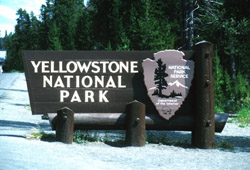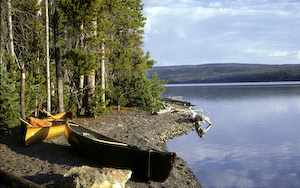 * Perhaps the world's most iconic national park thanks to its parks-movement history, incredible geology, and rich fount of wildlife, Yellowstone is both the standard-bearer and lightning rod for the national park system. Controversy swirls around the park, whether the issue is wildlife management or winter access. And that's unfortunate, for Yellowstone is a precious, beautiful preserve of nature, one that constantly delights and challenges visitors to learn more about the natural world, and those facts shouldn't be obscured by controversy. Whether you come in search of the world's greatest collection of geothermal features, to spy wolf, bear and moose, for long hikes into the wilderness, to camp along rivers or lakes, or to paddle away from civilization, Yellowstone can end your search.
* Perhaps the world's most iconic national park thanks to its parks-movement history, incredible geology, and rich fount of wildlife, Yellowstone is both the standard-bearer and lightning rod for the national park system. Controversy swirls around the park, whether the issue is wildlife management or winter access. And that's unfortunate, for Yellowstone is a precious, beautiful preserve of nature, one that constantly delights and challenges visitors to learn more about the natural world, and those facts shouldn't be obscured by controversy. Whether you come in search of the world's greatest collection of geothermal features, to spy wolf, bear and moose, for long hikes into the wilderness, to camp along rivers or lakes, or to paddle away from civilization, Yellowstone can end your search.
* Prime tourist season in Yellowstone is July and August, though September is not far behind. That, of course, is largely due to the school vacation schedules, for who wouldn't want to visit in late spring when renewal is under way both in the forests and across the hillsides as well as in the wildlife communities, or in late September, when shivering caches of golden aspen are daubed across the park, when animals are heading to the river valleys in advance of winter, when the earthy smell of fall hangs in the air? Winter is equally enticing, for the bracing cold, the heavy beards of ice carried by bison, the walls of ice that rim some geysers, and for the endless acres of snow that lure skiers and snowshoers into the landscape.
* Only time for one hike in Yellowstone? That's unlikely, because if you've made plans to visit the park you've decided to stay for more than just one or two days. Nevertheless, if geysers and hot springs are what you want to cross off your list, then the boardwalk stroll around the Upper Geyser Basin is for you. This leads you past all the major features -- Old Faithful, Geyser Hill with Giantess, Plume and Beehive geysers as well as the Lion Group, the Castle-Grand Group, the Giant-Grotto Group and the Morning Glory-Riverside Group. If that's not enough, follow the trail across the Grand Loop Road to Black Sand Basin to view Sunset Lake, Rainbow Pool, and Emerald Pool. For some serious long-distance mileage, head south from Old Faithful to Cascade Corner via the Bechler River Trail. Thirty miles in length, this route will lead you from geysers to the park's grandest collection of waterfalls.
* Best adventure? This could range from something as simple as
heading to the Lamar Valley in late spring to watch the interaction of
wildlife -- wolves, grizzlies and elk -- to a more complex and
demanding endeavor such as loading your canoe and pushing off from the
Grant Village boat ramp to explore Yellowstone Lake's southern arms.
Or, in winter, it could involve snowshoeing through knee-deep snow to
the lip of the Grand Canyon of the Yellowstone.
* Best places to
view wildlife. For wolves, the Lamar Valley in winter and spring, for
bison the Hayden Valley, for grizzlies the Lamar Valley in spring, for
elk the grounds at Mammoth Hot Springs.
* Kid-friendly
activities abound, from touring the geyser basins to counting bison, elk, wolves and bears. New this summer is the Young Scientist
Program being offered at Old Faithful and Canyon. For $5 you can buy
your child a self-guiding booklet that helps them explore, and learn
about, the park's natural history. This program rewards kids aged 5 to
7 with a Young Scientist patch, while those 13 and older receive a key
chain.
 * The best way to flee crowds in Yellowstone is to
simply step off the pavement and head down a trail. It doesn't have to
be a long trail, either. The 1-mile walk to Mystic Falls, which was
formed by a 100-foot drop of the Firehole River, will generally
suffice. Another good one is the All Persons Self-Guiding Trail on the
Blacktail Plateau. This trail, created after wildfires swept
Yellowstone during the hot, dry summer of 1988, shows many examples of
how nature functions in the park.
* The best way to flee crowds in Yellowstone is to
simply step off the pavement and head down a trail. It doesn't have to
be a long trail, either. The 1-mile walk to Mystic Falls, which was
formed by a 100-foot drop of the Firehole River, will generally
suffice. Another good one is the All Persons Self-Guiding Trail on the
Blacktail Plateau. This trail, created after wildfires swept
Yellowstone during the hot, dry summer of 1988, shows many examples of
how nature functions in the park.
* Best dinner? That can be
found in the elegant Lake Hotel, where chefs create such culinary
wonders as pan-seared elk medallions, huckleberry butter, and broiled
lobster tail, or a Portabella steak with Cabernet vegetable demi-glaze,
sauteed spinach and lyonnaise potatoes, or fettucine with wild smoked
Alaskan salmon. Of course, the dinners at the Old Faith Inn or the Old
Faithful Snow Lodge or Mammoth Hotel aren't much of a step down, but
there's just something about dining in Lake Hotel with its view of
Yellowstone Lake that gets a nod for the best dining experience in the
park.
* Yellowstone's best breakfasts, both for variety and price, are the
breakfast buffets you'll find at the lodges. These all-you-can eat
wonders offer egg dishes, grill items, hot and cold cereals, fresh
fruits, cheese blintzes, breakfast meats, yogurts and more. All for
just about $11 for adults and about $5 for kids.
* Best lodging, price not an issue, goes to the Lake Hotel. Premium
rooms -- those that front Yellowstone Lake and which strive to capture
the hotel's 1920s ambiance -- list for $201/night this summer. That's
steep, particularly if you're planning a week's stay. But the rooms are
wonderfully appointed with plush quilts on the beds, roomy bathrooms,
and great views.
* Best bargain lodging? Well, you could opt for the
bargain-basement Roughrider Cabins at Roosevelt Lodge, which go for
just $61/night and require you use a communal bathroom. But I prefer
the Western Cabins associated with the Old Faithful Snow Lodge. This
motel-style units stand in clusters of four, are clean, have
comfortable beds and decent bathrooms, and run but $127/night, or
nearly $60 less than a room within the Snow Lodge itself.



Add comment